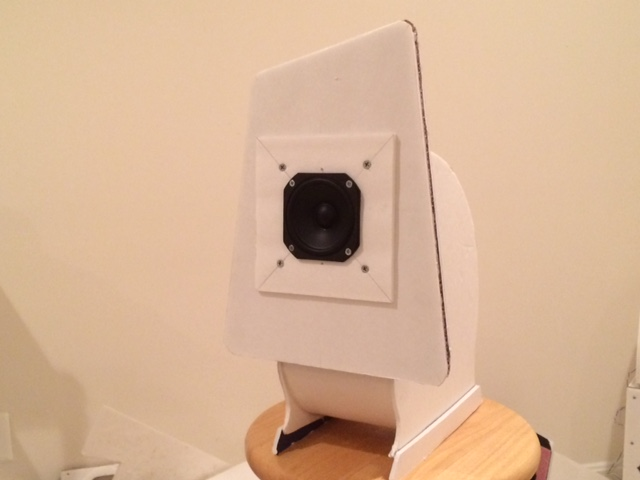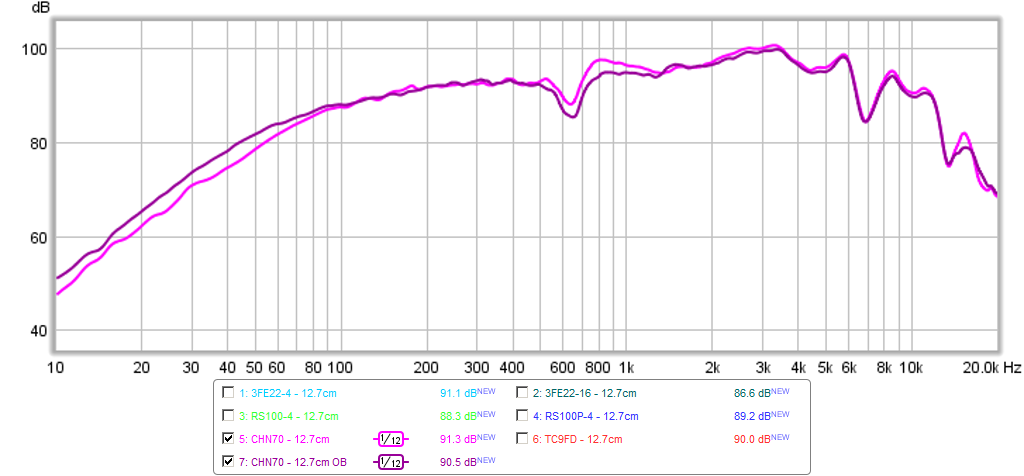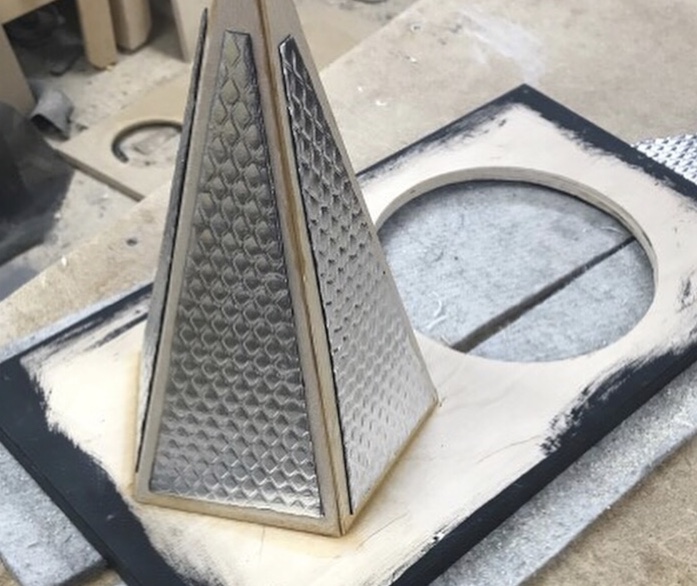I doubt that. A person knowledgeable about speakers here confirmed it, but added it was a little counterintuitive
Well, when you say constant directivity, it means dipole from bottom to top. As far as I understand, it only means constant diffusion = constant comb filtering from bottom to top.
Make the box have less parallel - parallel walls. The extreme case is the B&W Nautilus. You can make a cheap and easy Nautilus using spiral chamber foam core box which I call the Nautiloss. The Nautiloss and trapezoid baffle measures almost identical to a large open baffle:


No coloration of the box at all. The dips and peaks are intrinsic to the CHN-70 driver.
A rhomboid shape box works too or a triangle. I use a tall pyramid which I call the Dagger. It acts like an acoustic Wood’s horn or black hole. Stuff it progressively denser towards the vertex and very loose near the mouth. This lets the acoustic impedance vary as the sound reaches father back. Use melamine foam to line walls. Make the baffle a trapezoidal shape or at minimum, a rectangle. Avoid circles or symmetric square shape. The diffraction pattern from a trapezoid is less than rectangle. A flower petal shape baffle actually works really well. But if you must use a rectangular prismatic box, line walls with melamine foam and use stuffing. Sometimes a diagonal brace inside can also help break up box mode resonances.
My Dagger with a trapezoidal baffle measures and sounds the same as an infinite baffle (open on the back).


No coloration of the box at all. The dips and peaks are intrinsic to the CHN-70 driver.
A rhomboid shape box works too or a triangle. I use a tall pyramid which I call the Dagger. It acts like an acoustic Wood’s horn or black hole. Stuff it progressively denser towards the vertex and very loose near the mouth. This lets the acoustic impedance vary as the sound reaches father back. Use melamine foam to line walls. Make the baffle a trapezoidal shape or at minimum, a rectangle. Avoid circles or symmetric square shape. The diffraction pattern from a trapezoid is less than rectangle. A flower petal shape baffle actually works really well. But if you must use a rectangular prismatic box, line walls with melamine foam and use stuffing. Sometimes a diagonal brace inside can also help break up box mode resonances.
My Dagger with a trapezoidal baffle measures and sounds the same as an infinite baffle (open on the back).
Last edited:
Yes to your first sentence if you mean the spectrum. I don't understand the second sentence.Well, when you say constant directivity, it means dipole from bottom to top. As far as I understand, it only means constant diffusion = constant comb filtering from bottom to top.
A flower petal shape baffle actually works really well.
A flower type shape would make a very good dipole out of fullrange driver, a nice compromise smoothing out the diffraction that would be inevitable.
If you want to try 5 sided (pentagonal), the angle of the "miter" is 54 degrees for the edge that mates with the next edge also having 54 degrees, etc. so instead of having a square of 90 degrees at each corner; you now have 108 degrees at each "corner". If you have a table saw or a radial arm saw this is much easier. I did it with a hand held circular saw but used a saw guide. I got very good results but admit it was more tedious than a regular rectangle. This eliminates (or at least minimizes) standing waves; you also need to make the top not parallel to the bottom for the full effect.
@scottjoplin, I mean room interaction, more diffusion only cause more complex comb filtering in the room.
Yes, but I think that's why constant directivity speakers have never been mainstream in both consumer and professional world. In real world, it would not be ideal.
excuse me
From one old speaker guy to another, the miter for a pentagon is 36 degrees.
This adds up to 72 degrees. 360/5= 72.
I have built several pentagon shaped speakers. It addresses issues internally as well as externally. The remaining challenge is the top and bottom which are still parallel to each other. I would like to hear your ideas on how you have addressed this issue. Thanks !
If you want to try 5 sided (pentagonal), the angle of the "miter" is 54 degrees for the edge that mates with the next edge also having 54 degrees, etc. so instead of having a square of 90 degrees at each corner; you now have 108 degrees at each "corner". If you have a table saw or a radial arm saw this is much easier. I did it with a hand held circular saw but used a saw guide. I got very good results but admit it was more tedious than a regular rectangle. This eliminates (or at least minimizes) standing waves; you also need to make the top not parallel to the bottom for the full effect.
From one old speaker guy to another, the miter for a pentagon is 36 degrees.
This adds up to 72 degrees. 360/5= 72.
I have built several pentagon shaped speakers. It addresses issues internally as well as externally. The remaining challenge is the top and bottom which are still parallel to each other. I would like to hear your ideas on how you have addressed this issue. Thanks !
Last edited:
Pentagonal pyramid aka the Dagger, has no parallel walls.

I am not sure what the angle of the cut is since it’s a pyramid.
I am not sure what the angle of the cut is since it’s a pyramid.
I found I get least box sound with smaller boxes.
I can only guess the smaller panels are more rigid and don't flex as much.
I can only guess the smaller panels are more rigid and don't flex as much.
Thank you, so you think the 'box sound' is mainly due to internal reflections and panel vibration.A box with no parallel (internal) surfaces really helps; an Aperiodic vent can also help. This is addition to wall dampening, box stuffing, etc. If you have internal bracing; these should also be non-parallel to any inside surface. Not as easy to design or build but the results are well worth it.
Thank you. I have tried Golden Ratio, asymetric bracing and different stuffing, but I never went as far as you did, so maybe time to try trapezoidal.Make the box have less parallel - parallel walls. The extreme case is the B&W Nautilus. You can make a cheap and easy Nautilus using spiral chamber foam core box which I call the Nautiloss. The Nautiloss and trapezoid baffle measures almost identical to a large open baffle:
No coloration of the box at all. The dips and peaks are intrinsic to the CHN-70 driver.
A rhomboid shape box works too or a triangle. I use a tall pyramid which I call the Dagger. It acts like an acoustic Wood’s horn or black hole. Stuff it progressively denser towards the vertex and very loose near the mouth. This lets the acoustic impedance vary as the sound reaches father back. Use melamine foam to line walls. Make the baffle a trapezoidal shape or at minimum, a rectangle. Avoid circles or symmetric square shape. The diffraction pattern from a trapezoid is less than rectangle. A flower petal shape baffle actually works really well. But if you must use a rectangular prismatic box, line walls with melamine foam and use stuffing. Sometimes a diagonal brace inside can also help break up box mode resonances.
My Dagger with a trapezoidal baffle measures and sounds the same as an infinite baffle (open on the back).
AFAIK the effect of an absorber is dependent on the distance to the reflecting wall, the thicker the absorber, the deeper it works. What is the effect of 8mm (1/3 inch) thick felt ?
For pentagonal parallel top and bottom I fit an angled deflector on one of them.
Incidentally, does anyone else find that acousic foam lining results in a dead sound? I find wadding much better.
Incidentally, does anyone else find that acousic foam lining results in a dead sound? I find wadding much better.
Last edited:
For an enclosure than is long but narrow, which has properties like a tube, the longer wavelengths of the frequencies involved in the length resonance are going to have a reduced awareness of the smaller angled panels at the ends. Higher frequencies will in this dimension be more responsive to damping.
Is an uneven power response another cause of "boxy sound"?Yes, but I think that's why constant directivity speakers have never been mainstream in both consumer and professional world. In real world, it would not be ideal.
The idea to reduce box sound is to create a single dimension reflection instead of three. The Nautilus is an example, a tower is more common. The vertical reflection standing wave is damped by holed plates all along the length that each chamber acts as inductance and the holed plate as resistance, making it several low pass filters in series. The labyrinth enclosure, nowadays obsolete, is another solution. The egg shape enclosure uses wide bandwidth resonance, as music instruments.
Last edited:


Im making lossy boxes to my midrange horns, sound varies too much without rear damping, gonna fill these with felt and stuff to get needed result.
Before these i had 50% open system and they were dampened with 2 pillows
yes, the math that adds up says that. But, when you make the cuts, the angle on the edge is 54 degrees, not 45 degrees. I will double check; it has been decades since I did this. I did this very old school back in the day. I used graph paper and a compass and a protractor, etc.
I did the top at an angle of maybe 30 degrees. This was VERY tricky for sure. Looking at the front of the box; the top sloped down from front to back.
First coffee now; I'll get back to you; just now barely past 6 AM Saturday in the middle of the USA...
I did the top at an angle of maybe 30 degrees. This was VERY tricky for sure. Looking at the front of the box; the top sloped down from front to back.
First coffee now; I'll get back to you; just now barely past 6 AM Saturday in the middle of the USA...
- Home
- Loudspeakers
- Multi-Way
- What can I do against 'box sound' ?